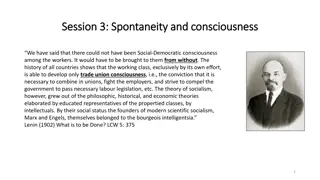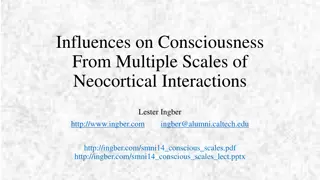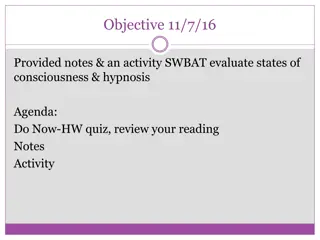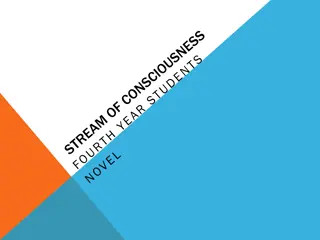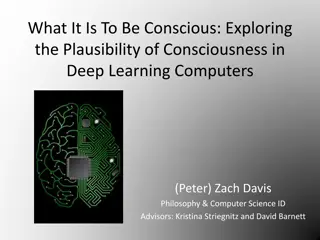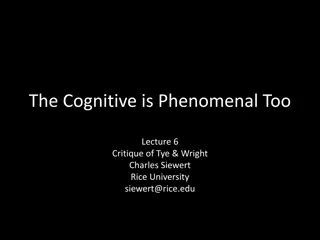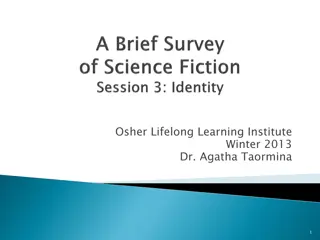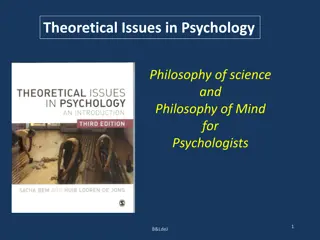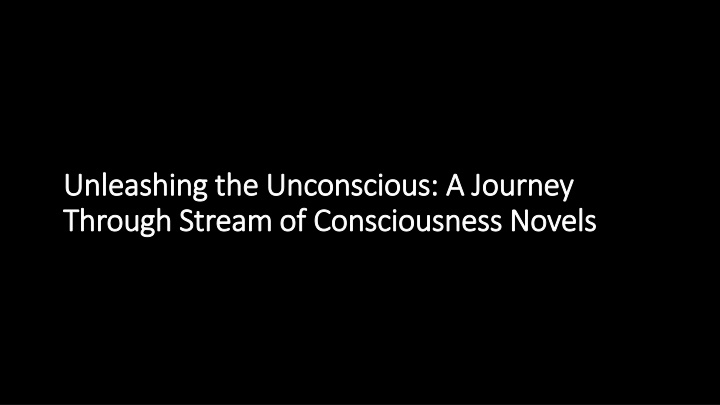
Journey Through Stream of Consciousness Novels
A journey through the world of stream of consciousness novels, exploring the history, techniques, significance, and impact of this unique literary style. Discover how authors like James Joyce and Virginia Woolf shaped modern literature with their innovative portrayal of characters' inner thoughts and emotions.
Download Presentation

Please find below an Image/Link to download the presentation.
The content on the website is provided AS IS for your information and personal use only. It may not be sold, licensed, or shared on other websites without obtaining consent from the author. If you encounter any issues during the download, it is possible that the publisher has removed the file from their server.
You are allowed to download the files provided on this website for personal or commercial use, subject to the condition that they are used lawfully. All files are the property of their respective owners.
The content on the website is provided AS IS for your information and personal use only. It may not be sold, licensed, or shared on other websites without obtaining consent from the author.
E N D
Presentation Transcript
Unleashing the Unconscious: A Journey Unleashing the Unconscious: A Journey Through Stream of Consciousness Novels Through Stream of Consciousness Novels
Introduction Introduction What is a Stream of Consciousness Novel? What is a Stream of Consciousness Novel? History of Stream of Consciousness Novels History of Stream of Consciousness Novels Techniques Used in Stream of Consciousness Techniques Used in Stream of Consciousness Novels Novels The Significance of Stream of Consciousness Novels The Significance of Stream of Consciousness Novels Famous Stream of Consciousness Novels Famous Stream of Consciousness Novels Criticism of Stream of Consciousness Novels Criticism of Stream of Consciousness Novels Stream of Consciousness in Modern Literature Stream of Consciousness in Modern Literature Conclusion Conclusion Q&A Q&A
What is a Stream of Consciousness Novel? What is a Stream of Consciousness Novel? A stream of consciousness novel is a literary technique that aims to capture the inner workings of a character's mind as they experience events in real- time. Unlike traditional narrative styles, which often rely on a linear plot and external descriptions of characters and events, stream of consciousness novels prioritize the subjective experiences of the protagonist. This can result in fragmented and nonlinear narratives that reflect the chaotic nature of human thought. One example of a stream of consciousness novel is James Joyce's 'Ulysses,' which follows the thoughts and experiences of several characters over the course of a single day in Dublin. Another example is Virginia Woolf's 'Mrs. Dalloway,' which explores the inner life of an upper-class woman preparing for a party. Both of these works use interior monologue and free indirect discourse to convey the characters' thoughts and emotions.
History of Stream of Consciousness Novels History of Stream of Consciousness Novels Stream of consciousness is a narrative style that originated in the early 20th century and is characterized by a flowing, unstructured form that mimics the natural thought process of the human mind. It was first used by writers such as James Joyce and Virginia Woolf, who sought to capture the complexity and depth of human consciousness in their works. Notable examples of stream of consciousness novels include Joyce's Ulysses, Woolf's Mrs. Dalloway, and Faulkner's The Sound and the Fury. These works challenged traditional narrative structures and paved the way for experimental literature in the 20th century.
Techniques Used in Stream of Consciousness Techniques Used in Stream of Consciousness Novels Novels Stream of consciousness novels employ a variety of techniques to convey the inner thoughts and experiences of characters. One of the most common techniques is interior monologue, where the character's thoughts are presented in a continuous flow, without interruption or commentary from the narrator. This technique allows the reader to experience the character's thoughts and emotions in a more immediate and intimate way. James Joyce's Ulysses is a famous example of a novel that uses interior monologue extensively. Another technique used in stream of consciousness novels is free indirect discourse, which blends the character's thoughts with the narrator's voice. This creates a unique narrative voice that reflects the character's perspective while still maintaining some distance from their thoughts. Virginia Woolf's Mrs. Dalloway is a notable example of a novel that employs free indirect discourse to great effect.
The Significance of Stream of Consciousness The Significance of Stream of Consciousness Novels Novels Stream of consciousness novels have had a profound impact on literature, challenging traditional narrative structures and exploring the inner workings of the human mind. By breaking free from the constraints of linear storytelling, these works have opened up new possibilities for writers and readers alike. Furthermore, stream of consciousness novels have also had a significant impact on society, providing a platform for marginalized voices and challenging dominant cultural narratives. These works have helped to expand our understanding of the world and our place in it, fostering empathy and promoting social change.
Famous Stream of Consciousness Novels Famous Stream of Consciousness Novels One of the most famous and influential stream of consciousness novels is James Joyce's "Ulysses." This epic work follows the lives of several characters over the course of a single day in Dublin, using a range of styles and techniques to capture their thoughts and experiences. Another notable example is Virginia Woolf's "Mrs. Dalloway," which explores the inner life of its protagonist as she prepares for a party. The novel moves seamlessly between different perspectives and time frames, creating a vivid portrait of London society in the early 20th century.
Criticism of Stream of Consciousness Novels Criticism of Stream of Consciousness Novels One of the main criticisms of stream of consciousness novels is that they can be difficult to understand. With their lack of traditional narrative structure and emphasis on interior thoughts and feelings, some readers may find them confusing or inaccessible. Another criticism often leveled at stream of consciousness novels is that they can be elitist. Because they require a certain level of literary knowledge and sophistication to fully appreciate, some argue that they cater only to a small, intellectual audience.
Stream of Consciousness in Modern Literature Stream of Consciousness in Modern Literature In modern literature, stream of consciousness techniques have been used in a variety of genres, from science fiction to romance novels. These techniques allow authors to delve deeper into their characters' inner thoughts and emotions, giving readers a more intimate understanding of their experiences. For example, in science fiction, stream of consciousness can be used to explore the complexities of futuristic societies and the psychological impact of technological advances. In romance novels, it can be used to convey the intensity of romantic relationships and the ups and downs of falling in love.
Conclusion Conclusion In conclusion, stream of consciousness novels are a unique and important genre in literature. By allowing readers to experience the inner thoughts and emotions of characters in real time, these works offer a more immersive and authentic reading experience. They also challenge traditional narrative structures and push the boundaries of what is possible in storytelling. From their origins in the early 20th century to their continued influence on modern literature, stream of consciousness novels have had a significant impact on the literary world. By exploring the complexities of human consciousness and emotion, these works offer valuable insights into the human experience and help us better understand ourselves and each other.
Q&A Q&A Thank You, let's engage in a lively Q&A session and gather feedback on the presentation. Looking forward to hearing your questions and thoughts.











